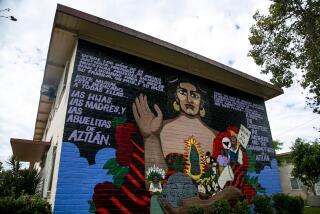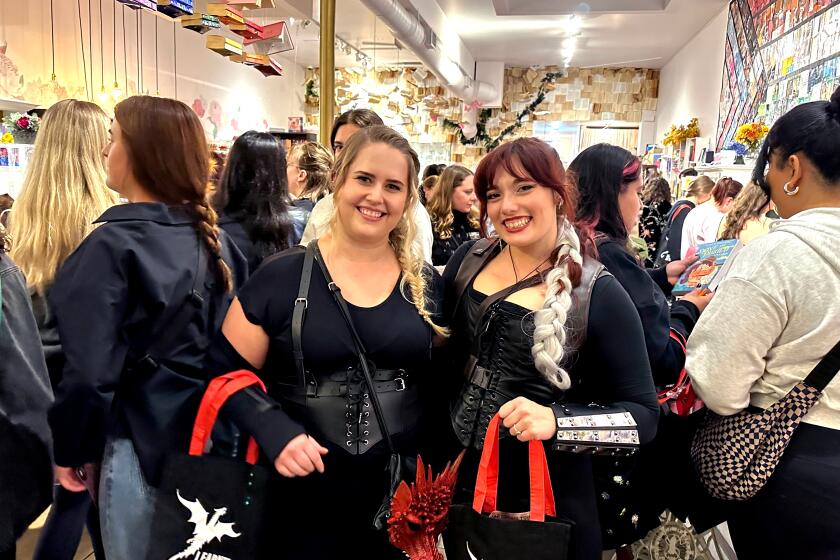Elegy for El Monte
- Share via
Meeting Salvador Plascencia, the author of “The People of Paper,” one half expects to find his pants on fire. Born in Mexico and raised in the San Gabriel Valley town of El Monte, the 28-year-old has made his acclaimed debut with a book set largely in El Monte and Mexico and called “part memoir, part lies.” Plascencia’s El Monte is a magical realist dream world that doubles as a war-torn front line in a mythic struggle against sadness. There’s a fearsome commander who wets his bed and a canonized saint who takes refuge in a Tijuana wrestling ring. Printed by the Rectangulars imprint of McSweeney’s, the San Francisco-based avant-indie publisher, the book upholds the McSweeney’s tradition of meta-fictional experimentation with features such as a tyrannical author/protagonist intermittently referred to as Salvador Plascencia and tiny oblong cutouts on pages where the character has bitterly excised the name of his ex-girlfriend’s new paramour. We tracked down the flesh-and-blood Salvador Plascencia only to discover the shy, diminutive soul house-sitting in Silver Lake. We asked if he could assist in separating fact from fiction, myth from reality, and people from paper.
There are many Latino culture collectives. Why did you publish with McSweeney’s, home to an aesthetic associated with white writers such as Dave Eggers and David Foster Wallace?
The Latino imprints never called when it was going around. McSweeney’s called. But I’m very happy because now the book doesn’t get reviewed as a “Latino imprint” book, but as a book. As a writer, I align myself with aesthetics, not ethnicity. Why is Jonathan Safran Foer not published by a Jewish American press? Should John Edgar Wideman and Toni Morrison be published only by black presses? There is something comforting in the fact that these ethnic collectives exist, but they can also have a ghettoizing effect.
Cardinal Roger Mahony makes an appearance in “The People of Paper,” but the character doesn’t bear much resemblance to the real-life public figure.
I needed a cardinal. It’s a book about L.A., so I used Cardinal Mahony. People that are part of the Catholic Church, they have to love God but surrender romantic love. How do I imagine that Cardinal Mahony came to religion, how does he forsake romantic love?
Your book’s design includes holes cut in pages, blacked-out text and jumbled fonts and margins. Are these clever gimmicks?
When people speak of typography, they always say “gimmick.” What’s the difference between a gimmick and a device? Historically, if you look at manuscripts in monasteries, if you look at the early books of Laurence Sterne, those books were wild. There were columns. There were woodcuts. There [was] wild, flourishing typography and text intruding on text. We’ve moved away from the kind of lusciousness of typography and of layout into this stringent two columns on a page. Even a newspaper does typographical tricks, and somehow we’re OK with that. But if literature does it, that’s odd or weird.
The book is dedicated to a “Liz.” Is there really a Liz?
That’s part of my ambition, to confuse fact and fiction. There is a Liz. But if you said there is this woman named Liz, then you have to also say that she is constructed from paper and that people walk around with halos on their heads setting fire to their hotel’s curtains.
Is there a connection between your Catholic upbringing and the physical torments nearly all the major characters must endure in your book?
I never noticed that the characters got abused so much until I finished. There’s a gash. There’s blood. You always think about saints, torture, how they become martyred. Growing up, the saints were like superheroes. They were fantastic people of powers, and whatever happened to them, the consequences were always noble.
If your work had cousins on the shelf of L.A. literature, who would you say they were?
I would love to say Mike Davis. He has this way of reconfiguring space, making you look at it differently. As a writer, it’s very valuable.
More to Read
Sign up for our Book Club newsletter
Get the latest news, events and more from the Los Angeles Times Book Club, and help us get L.A. reading and talking.
You may occasionally receive promotional content from the Los Angeles Times.










